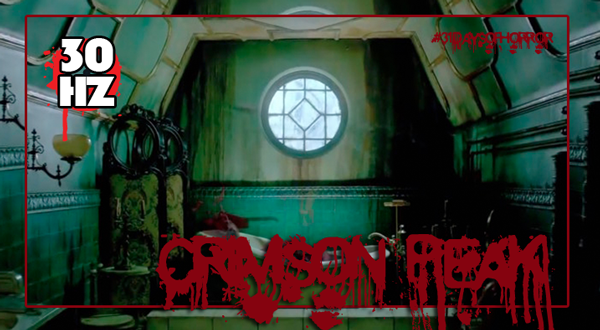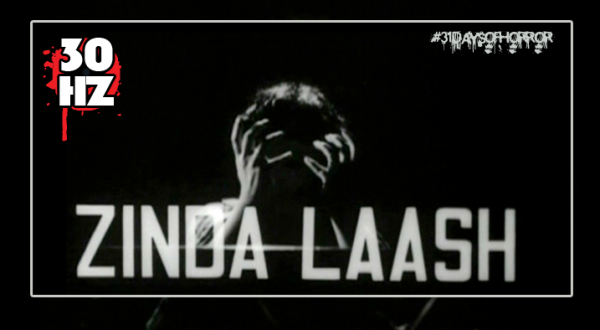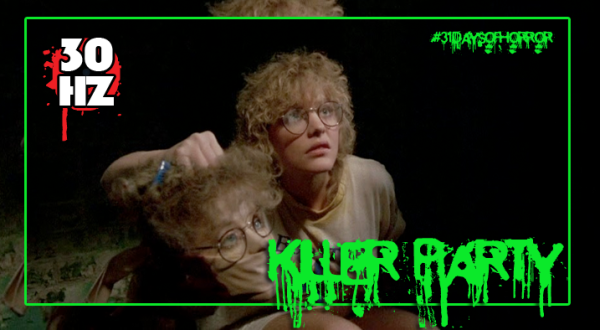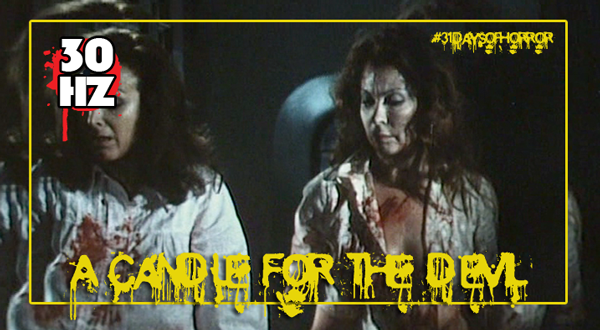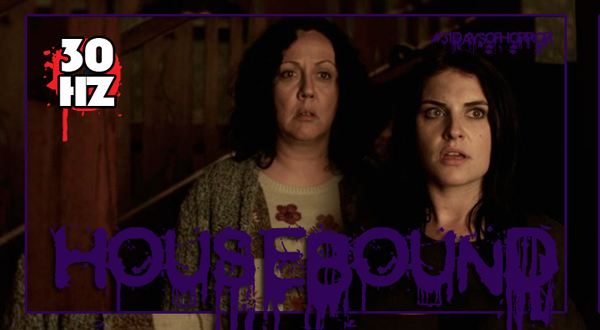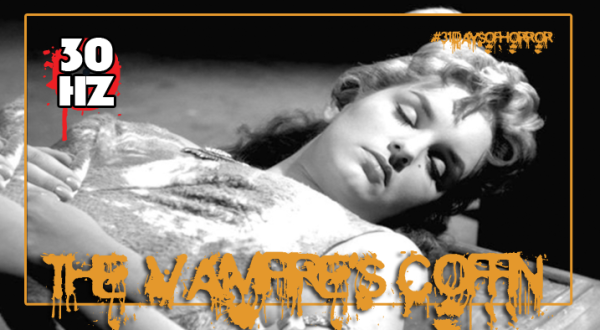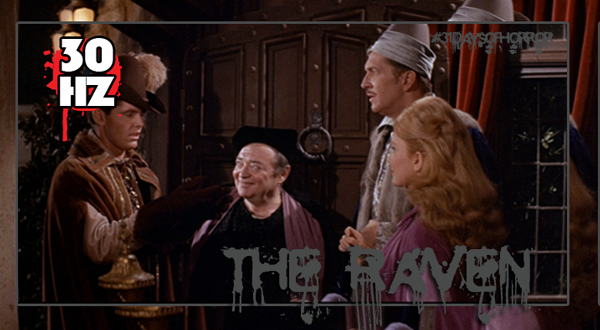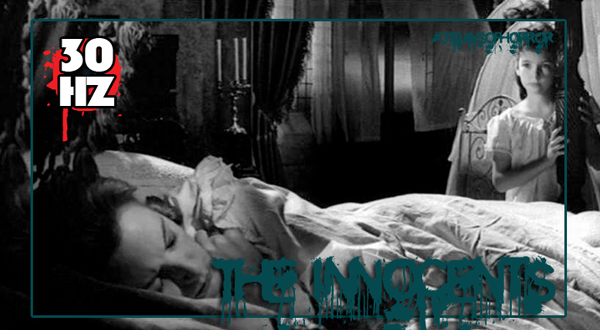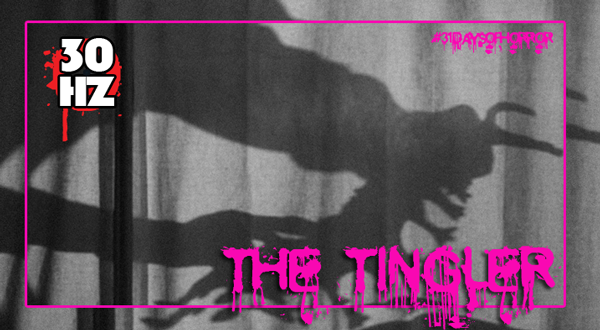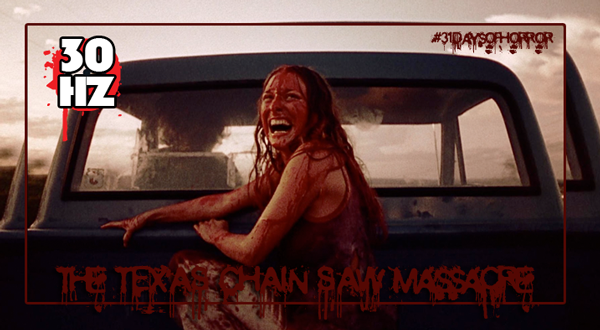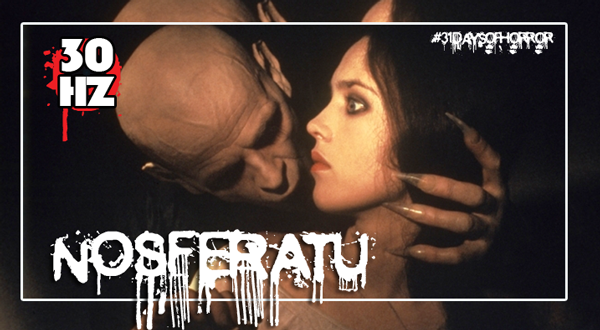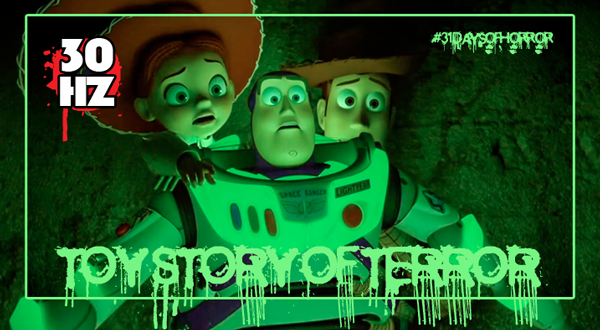We’ve passed October’s midway point. The 15th has come and gone. The one-per day pace has officially slagged and I’m staring down the barrel of a final, grueling, monstrous, harrowing 16 final days to complete the 31 films required of me in the 2015 31 Days of Horror Shame-a-thon. I’ve been eyeballing a bunch of new non-horror DVD and Blu-ray acquisitions and wishing I could toss one in, just give it a quick watch. But alas. I’ve no time for anything other than horror. I’ve no time for Rock Band 4. No time to read the stack of books on my nightstand. There’s kids. There’s sleep. There’s work. There’s horror. There’s me and this stack of shamefully unwatched horror flicks. I’m redoubling my efforts (what does that even mean?). I’m not only going to beat my record of 27, I’m going to hit that magical #31. I’ve even Jedi mind-tricked the wife into asking what’s next on the horror schedule.
I’ve started this second post for ease of reading, simplicity of coding and preservation of sanity. The first post grew wonky in the saggy middle bits and constantly reformatted and ignored my header and paragraph tags. Clearly the work of a pesky poltergeist in the css.
THE great discovery of 2015 has not yet happened. Last year I viewed many new favorites. The Whip and the Body. The Lair of the White Worm. Night of the Comet. Vampyr. So much goddamn bloody goodness. But then again I’ve just skimmed the surface of my list of Shame. I’ve not even delved into the 1980’s picks, and you know I love me some Reagan-era trickle-down terror. (I’m also expecting great things from you, Pakistani Dracula.)
Past #31DaysOfHorror Shame-a-thons: 2013 | 2014 | 2015 Part 1
- Cat and the Canary (1927)
Island of Lost Souls (1932)The Picture of Dorian Gray (1945)La Momia Azteca (1957)Scream of Fear! (1961)The Innocents (1961)- Burn Witch Burn (1962)
- Kwaidan (1964)
Nightmare Castle (1965)The Living Corpse (Pakistani Dracula! – 1967)The Living Skeleton (or another from When Horror Came to Shichoku Eclipse Set, 1968)- Koroneku (1968)
- Vampyros Lesbos (1971)
Amuck! (1972)- Night of the Devils (1972)
A Candle for the Devil (1973)The Wicker Man (1973)Sugar Hill (1974)Texas Chainsaw Massacre (1974, on 2014 and 2015 Shame lists)Alucarda (1977)Nosferatu (1979)- Without Warning (1980)
- Scanners (1981)
- The Boogens (1981)
- The Strange Case of Dr. Jekyll and Miss Osbourne (1981)
Fright Night (1985)- Nightmare on Elm Street 2 (1985)
Killer Party (1986)- Inugami (2001)
- Romasanta (2004)
- A Girl Walks Home At Night (2014)
Off the menu:
FrogsBeyond the Black RainbowComedy of TerrorsMST3K – It Lives By NightThe Beast With Five FingersCorruptionBram Stoker’s Dracula*Crimson PeakHouseboundThe Vampire’s CoffinThe RavenThe TinglerChamber of HorrorsThe Fog*
- – not a first time watch
(Hz ratings out of 5 Hz)
View the 2015 Shame-a-thon Part 1: entries #1-#13 here.
#14. 10/16 – Fright Night (1985, dir. Tom Holland)
“Marcy D’arcy! It’s Marcy D’arcy!”
So I was disproportionately excited to see Al Bundy’s uptight neighbor. I get like that when I unexpectedly stumble upon Marcy or Jefferson in the wild. Not so much Steve, though. Steve was a bit of a dullard. Did you know that Marcy (Amanda Bearse) also directed 30 episodes of Married with Children? #TheMoreYouKow, am I right?
But let’s put aside the Marcy D’arcy euphoria for a second.
Fright Night rocketed to the top of the 2015 Shame-a-thon. An old-fashioned monster flick with a dose of self-awareness, reverence for classic horror and a jab or two at the contemporary (1980’s contemporary, of course) slasher movies dominating the milieu. William Ragsdale’s a bit of a stiff, but his rigidity plays against Chris Sarandon’s hunka hunka mock-turtleneck sexy-time face. In the climax he also rocks a Nehru jacket-looking shirt thing, which, let’s face it, not everyone can pull off.
The practical gore effects are top notch, used sparingly and to great effect — especially Evil’s demise. And while we’re doting on some boring technical aspects of the film, let’s talk about the score. Brad Fiedel’s music for Fright Night blends traditional scoring with moody synth roots the film in 1985 without slipping into that sour “dated” category.
Since I like my horror flicks with a dose of smarts (not to mention Marcy D’arcy in peril) this is kinda my jam.
#15. 10/16 – Bram Stoker’s Dracula (1992, dir. Francis Ford Coppola)
So again it’s not technically a shame. Not technically. But this is my challenge and I can bend the rules whenever I see fit. And I saw fit last night because the Bram Stoker’s Dracula Blu-ray with the brand new 4K transfer arrived last week. As one of my favorite vampire films, I bent — nay broke the rules — of my own Shame-a-thon (again) in order to see how this transfer compared to the 8-year-old muddy Blu-ray dubbed “Dark-ula”. The Shame of course is that I owned the new Blu-ray for about 10 days before tossing it in on. Shame!
I come bearing good news. The new transfer is as good as this movie is ever going to look. The darkest scenes have a far superior color balance — it’s not just that they’re brighter, it’s that Coppola’s vivid colors have returned and detail remains even in the darkest shadows without sacrificing the deepest blacks. The scenes early on in Dracula’s castle provide ample proof that Sony has finally done right with this film.
Here’s the lesser news. Some crankshafts have noticed that there’s a small framing issue throughout the film. Before you go bridge jumping, let me attest that YOU WILL NOT NOTICE THE FRAMING ISSUE. I’ve seen this film enough to care about things like that. I thought one shot seemed a little… different. Not wrong. Just not what I remembered. Which is how I found these lunatic threads on DVD forums impaling this release.
If you want to join the hyperbolic legions of Interweb lunatics ranting about this new release, that’s your right and privilege as an anonymous blowhard with a Twitter account. If you want my opinion, however, your time is better spent just enjoying the film for what it is — a flawed but visually stunning masterpiece of gothic horror with a legendary performance by Gary Oldman (and maybe the best Van Helsing ever captured on film in Anthony Hopkins).
Also blood geysers, you guys.
#16. 10/18 – Crimson Peak (2015, dir. by Guillermo del Toro)
After watching Bram Stoker’s Dracula and Crimson Peak this weekend I had a very vivid dream last night about blood geysers.
— The #Bond_age_ McFly (@007hertzrumble) October 19, 2015
Thank goodness for Crimson Peak. Guillermo del Toro’s timely release of his latest directorial effort allowed me to attack 31 Days of Horror on multiple fronts. Blu-ray. DVD. Streaming. Theater. I’ve got 2015 completely flanked. I don’t often drag my carcass out to the theater for modern horror films because 99% of them are pure prefabricated shit meant to sell tickets to the lowest common denominator. People who will buy tickets to anything that promises a body count. There’s more to horror that torture and death and general psychotic mayhem. The genre has a long tradition of style and visual creativity dating back to its origins. The earliest silent horror films — Nosferatu, The Cabinet of Dr. Caligari just to have a couple of obvious examples — contain some of the most inventive cinematography ever captured on film. Horror does not equal gore, though that has its time and place as well (best used with equal parts comedy as unrepentant gore porn is just not my bag). Experiencing an effective horror film is the transference to a psychological state of persistent unease. Consider The Picture of Dorian Gray, a film I logged here as a horror film. Other than a stabbing and few unsettling shots of the decaying portrait, there’s no overtly horrific imagery, yet it remains the most disturbing film viewed in my Shame-a-thon to date. Guillermo del Toro’s Crimson Peak follows the director’s traditional storytelling pattern (at least in his horror entries). Create unease and then punctuate that unease with flourishes of gore and brutality. Crimson Peak, however, is no Devil’s Backbone, a film where the horrors linger, building to a final climax followed by the cathartic release of tension. Peak falls short of that modern classic, nor does it aspire to such heights. Like Dorian Gray, Crimson Peak is first a gothic romance, second a haunted house story, third a meditation on storytelling itself. The film proves largely effective at number 1, but only moderately effective at numbers 2 and 3. Peak undermines the gothic elements of the narrative with intermittently excessive and comical bloodletting. It is almost as if del Toro can’t help himself when a choice moment arises. A simple pen stabbing results in a massive spurting of blood. In a different movie, I’d have been pro-hyperbolic blood geyser, but Peak‘s pleasures are found elsewhere. In the dark corners of the house (a masterpiece of set design), in the true motives of Thomas Sharpe (Tom Hiddleston) and his sister Lucille (Jessica Chastain), in the practically-rendered (no CGI according to GDT) metaphors/apparitions that appear to Edith (Mia Wasikowska). Crimson Peak is the recipient of some critical negativity because it is largely predictable (true) and languorously paced (also true) and uneven (ditto) and because its visual splendors could not compensate for all of the above (poppycock). The power and purpose of “visual splendors” in film cannot be overestimated. The slower, gothic nature of the film will repel viewers hungry for a gory frightfest. I see why del Toro took to Twitter to normalize viewer expectation, insisting that the film is first a romance. Viewer expectation can be damning, so can the pre-existing baggage people bring into a moviegoing experience. No matter your expectation or disappointment with the elements of this particular ghost story, Crimson Peak should and will satisfy those patient souls willing to bask in the extraordinary “visual splendors” of this old fashioned, gothic yarn… albeit a gothic yarn dotted with a few potentially unnecessary blood geysers, face bashings and questionably stunted dialogue.
#17. 10/19 – The Living Corpse (1967, dir. Khwaja Sarfraz)
The more than 10-minute pre-title sequence depicts a doctor struggling to create a potion for everlasting life. After many failures (we know because the formula melted through the flask) he succeeds. Before taking the potion he leaves a note for his assistant to toss him in the basement coffin once she finds him passed out on the floor. Later he shows up to suck her blood. We presume, anyway, because the film cuts away just before his shiny new teeth contact her succulent flesh. After the wonderful, high-contrast title sequence (pictured above) we’re treated to a lively rendition of “La Cucuracha” as a pimpmobile (color uncertain) traverses the rugged Mexican Pakistani landscape. And so it goes with Zinda Laash aka The Living Corpse aka Dracula in Pakistan. Though director Surfraz had clearly mastered the use of light and shadow, the film gives rise to many other questions: What are the logistics of the Dr. Aqil/Mr. Dracula situation? Hey girl, is that supposed to be sexy dancing? “Feed on this instead.” Wait, was that a baby? So more full-clothed sexy dancing already? Well, alright. Did Burt Bacharach watch this before scoring the “Raindrops Keep Falling on My Head” scene in Butch Cassidy? The Living Corpse took obvious cues from 1958’s The Horror of Dracula. Not having seen the film for some time, I can’t actually confirm that the film goes shot-by-shot but it certainly feels that way. Sarfraz also takes specific details from Bram Stoker’s novel that didn’t appear in other films at this time. The way it processes these elements, inherently British and Christian, through the Pakistani cultural lens make for fascinating viewing. If you like your Dracula with a dose of kitsch and cultural transmogrification, The Living Corpse must be seen to be fully appreciated.
#18. 10/20 – Killer Party (1986, dir. William Fruet)
I’d normally give a resounding thumbs up to any movie prominently featuring Laura Branigan on the soundtrack. Then I met Killer Party. Taking cues from House on Sorority Row, Private School, and The Evil Dead or The Exorcist (hell, it doesn’t really matter, just something with malleable rules about demonic possession), Killer Party resembles a meta-slasher movie. But Fruet’s film is neither witty enough to succeed at the meta part or creepy enough to succeed at the slashing part. The opening promised something spectacularly awesomeful, like Night Train to Terror. It begins as a drive-in movie within a White Sister hair-metal rock video within a movie. Ten minutes in you don’t know what’s going on but you’re digging it. Soon the movie settles into Private School meets House on Sorority Row and you’re left wondering where all the cool, kitschy, meta bits went. I was kinda entertained… but at what cost? Even my shameful affection for all things from the mid-1980’s has limitations.
#19. 10/21 – A Candle for the Devil (1973, dir. Eugenio Martin)
Lady butcher sisters enforce their strict moral code with knives, hatchets and the promise of raging, eternal hellfire. The movie’s languid pace will challenge some, engage others. I fell somewhere in between, but confess I was duly impressed by the moodiness of the cinematography and the fascinating distortion of Catholic teachings about sex, faith and “perversion” — a distortion that seems to be playing out in 2015 through politicized “faith-based” pandering to the moral right. There’s not a lot of exploitative gore — a stylistic choice that allows the unsettling mix of sex and religion to strike a nerve more squarely. One might rightly assume that there’s some talk of Satan in a movie called A Candle for the Devil — but unlike Alucarda, which wasted no opportunity to reference the subversive bastard, Candle leaves that sort of chatter in the subtext (and presumably to pander to an audience expecting something more notorious than a meditation on the continued relevance of Catholic doctrine). This is the story of two emotionally damaged women struggling to carve their own place in an increasingly frivolous, libidinous and morally uncertain world. A fascinating and obscure entry in the Eurotrash cannon — Eurotrash as character study — something I certainly never expected to find in this Spanish cult sleeper.
#20. 10/22 – Housebound (2014, dir. Gerard Johnstone)
I’ve had this one on my Netflix Watchlist for many moons. Someone told me it was really funny. The Netflix description promised ghosts and haunted houses. Okay, so there’s uncertain creaking and stuff, a Teddy Ruxpin bear gone rogue and some other freaky shenanigans. And there’s some extraordinarily glib moments of Kiwi humor… but I wouldn’t go as far to call it a full on comedy… or a full on horror movie. So now you’re asking — So what is Housebound then, jerk? Housebound is just a cool little movie from New Zealand. … What, did you want more explanation? Sigh. Well okay then. (Slave driver.) Kylie is forced to return to her childhood home, under house arrest, after failing miserably as a petty criminal. Mum’s a bit of a gossipy nutso and calls up talk radio tell stories about the spooks in the basement and creaks in the floorboards. It’s not long before Kylie gets the heebeejeebies and jumps on the notion that the house is haunted… or she’s merely becoming more like her mother the more she’s stuck in the house. (Both frightening propositions.) Kylie becomes a kind of paranormal investigator and uncovers the house’s violent secrets. Johnstone’s film is all that and a bag of nacho chips. I mentioned the spooks and the tongue-in-cheek goofs, but there’s also a measure of heart in this tale as mother and daughter reconnect. The film comes slightly undone during the climax which you might be able to overlook after being treated to a superfluous, but entirely welcome bit of gory bloodletting. The film succeeds most readily as it subverts expectation and twists genre tropes. So, if you’re like me, and Housebound has been staring at you on that Netflix Watchlist, now’s the time to cross it off. I definitely needed a fun and breezy flick after A Candle for the Devil. It’s Day 22. I’m also trying to sneak this writeup in at work while also watching my next entry (which has been happening in installments for about a week). With October winding down, there’s not a moment to spare. I’d also like to start reading books again at some point in the near future.
#21. 10/23 – The Vampire’s Coffin (1958, dir. Fernando Mendez)
…aka El ataúd del Vampiro which somehow makes it sound far more appealing than Dracula if he were a gameshow host… in Spanish. Other than some inventive scenes using high contrast light and shadows, The Vampire’s Coffin feels like a Universal film from the 30’s or 40’s, but less interesting. Static camera, smattering of close-ups, chiaroscuro. Also seemingly unrelated sick children worried about stuff. I’m not going to say I didn’t enjoy this movie because how can you not love making “gameshow vampire” cracks to yourself… but it just wasn’t very good and I watched it because it was available on Netflix while I wasted a couple of hours at work waiting for 48″ signs to print on the blotter. This is definitely a movie you watch while you’re waiting for something better to happen.
#22. 10/24 – The Raven (1963, dir. Roger Corman)
If you’ve ever wanted to see an improv group attempt to continue the narrative of Edgar Allan Poe’s “The Raven” poem, The Raven might just be the movie for you. I’m pretty sure that Peter Lorre and Vincent Price weren’t at any point reading from a script. Jack Nicholson arrives in full flummox mode and then there’s the luminous Hazel Court. It’s hard not to have a measure of affection for a production as ill advised as this. A raven drinking from a wine goblet. Peter Lorre in a bird suit. Vincent Price and Boris Karloff as accomplished witches (warlocks?) and Peter Lorre as the Daffy Duck variety witch (always a failed second fiddle). When you think the movie couldn’t go more off the rails, it does somehow. And that makes it… well… worth something to fans of Corman and those lovable, huggable AIP productions from the 1960’s. Nevertheless, you always believe that the actors had more fun making the movie than you had watching it.
#23. 10/25 – The Innocents (1961, dir. Jack Clayton)
…words coming soon…
#24. 10/26 – The Tingler (1959, dir. William Castle)
…words coming soon…
#25. 10/28 – Texas Chainsaw Massacre (1974, dir. Tobe Hooper)
This may be another case of a movie damned by expectation. Well, maybe not damned per say, but fricasseed, roasted and potentially boiled. TCSM had been held aloft as one of the most frightening experiences in cinema history. Unnerving, sure. I’ll give it that. Tense. Solid effort there. Tremendous foreshadowing through somewhat casual (but mostly forced) dialogue. But TCSM won’t keep me up at night like The Innocents, to name one very recent example that burrowed underneath my skin and lingered. Different goals. Different films, obviously. But it’s all relative, anyway, is it not? The specific details that cause certain films to climb into you subconscious and reside there, forever sending chills down the back of your spine. I’ve got a few of those. Candyman, for example. I watched Candyman alone just after it was released on video. Afterward I walked around the house turning on every light. I haven’t seen it since and I’m quite sure it wouldn’t affect me in the same ways it did then. That’s not the point. In specific moments in our lives we’re more receptive to certain types of horrors. And those horrors just don’t necessarily dissipate with time and tide. I will always think of that night and shudder, just a little bit. The same goes for the The Innocents. At age 37 I was fully ready to receive the chilling tale from 1961 in ways I wouldn’t have as a teenager. I might not have been as involved with the story, invested in the character, identifying with the horrors of small, manipulative children being puppet mastered by the lingering spooks of dead lovers. So that brings us back to 1974 and to this “true story” of the systematic murders of a group of stranded young motorists by a family of maniac butchers/cannibals. Though I engaged with the story (Step 1 of being receptive to horrors), I was mostly humored by the stupidity of the film’s “protagonists.” I documented these thoughts on Twitter, as I tend to do:
So the takeaway from TEXAS CHAINSAW MASSACRE is that you shouldn’t pick up hitchhikers that are f’ing insane. #31DaysOfHorror #lifehacks — The #Bond_age_ Guy (@007hertzrumble) October 28, 2015
More TEXAS CHAINSAW MASSACRE #LifeHacks. If you find a human tooth on the front porch of a house, you should leave. #31DaysOfHorror
— The #Bond_age_ Guy (@007hertzrumble) October 28, 2015
I’m stocking up on these TEXAS CHAINSAW MASSACRE #LifeHacks. If you fall on a floor full of bones and chicken parts, run now, puke later. — The #Bond_age_ Guy (@007hertzrumble) October 28, 2015
There were a few more of these, but you get the point. Hapless morons find themselves in a Murphy’s Law-type situation and in order to expedite the Murphy’s Lawness of it all, they just start flocking straight towards death like a moth to a flame. And the flame in this case is a guy wielding a chainsaw and wearing a skin mask of his victims. The parade of executions becomes preposterous. And then when there’s just one left, we’re treated to a “last supper” dinner scene featuring the entire family of deranged lunatics — truly a classic cinematic scene of the macabre. The final living protagonist is a girl named Sally — which is pretty much everything we know about Sally. This, the best scene in the film, is cruel, funny and believe it or not, humanizing… to the extent that you can humanize lunatic cannibals because he’s only okay with cooking his victims but not killing them. I get that. We as a first world society totally get that. We’re lunatic hillbilly murderers too. For the sake of bacon.
And this brings me to the not-so-subtext of the film. Texas Chain Saw Massacre is a pro-vegetarian propaganda piece. The characters document the horrors of the slaughterhouse and engage in a debate about whether its okay to eat meat but not kill it. They talk of headcheese processing and killing cows with two sledges to the head. This debate is so detailed in the various methods of cow executions, you know, YOU KNOW, this has to come back into the film at some point. And wouldn’t you know… the cannibal family cook states his reservations about killing his own ingredients, i.e. Sally.
Tasty, eh?
Was I entertained? No doubt. And in the end, that’s all that really matters… also keeping those TCSM #LifeHacks close at hand should you be presented with a situation where your van breaks down in the middle of Texas (how about let’s just not go to Texas?) and you find yourself looking for help in homes with dead things on the floor. Hey, these things happen and when they do, you want to be prepared.
#26. 10/29 – Nosferatu (1979, dir. Werner Herzog)
Dracula returns to the realm of the purely gothic. Herzog’s Count is a wretched cuss equated with the black plague. He’s a pestilence of rats and unwanted sexual advances. Klaus Kinski’s visage is the stuff of nightmares, rivaling only Max Schreck in the original 1922 F.W. Murnau Nosferatu that Herzog here aims to update. The movie lacks the eccentric, hyperbolic splendor or other Dracula adaptations. Every scene promises, eventually, the arrival of death. Every scene is carefully calculated forebode. Consider the scenes as Harker arrives in Transylvania. Herzog lingers on Harker’s inability to reach the castle. Peasants will not drive him, they will not even allow him to buy a horse to make the journey. Harker must walk the long distance. Popul Vuh’s haunting score (symphonic melodies and moans!) coupled with Herzog’s long, static shots of the treacherous splendor of the mountains and countryside put a shiver in your britches.
Herzog maintains the silent film’s languid pacing, allowing haunting visuals and extended silence to convey a creeping, menacing terror. Most striking is that Herzog doesn’t cloak his cinematography with effusive shadow. Nosferatu is often bright and always high-contrast, to the point of appearing overdeveloped. Even the scenes with Harker (Bruno Ganz) at Dracula’s castle are well lit affairs (relatively speaking). The most prominent visual effect of this lighting scheme, the blazing whites, bathe the character of Lucy (Isabelle Adjani) in chastity. She’s seen on the beach, pale, washed out skin the color of the bleached sky and sand. Her face contrasting against her black hair, stark clothing. Adjani (and to a greater extent Herzog’s mise-en-scene) here could be seen as a prototype for our modern Goth culture — and in that the culture as I understand it rose in popularity during the early 80’s as part of the gothic-rock/post-punk movement, this notion has some merit. Furthemore, an argument can and has been made that German Romanticism itself is responsible for the visual tropes associated with the Goth culture. I’m going to conclude that thought here. I don’t have the time or space for such rabbit holes here.
When Dracula arrives in London, proper darkness finally arrives with the beast. Our expectations of dread are met, duly. The events have been told dozens of times over. I should note that I’ve been listening to the film’s score for the last hour and I’m sufficiently batshit loopy. Time to do some proper work now, which for me today is some simple graphic design. I hope my employer’s in the mood for brooding, high-contrast blacks and washed out whites.
#27. 10/30 – Scream of Fear (1961, dir. Sean Holt)
A terrific film noir disguised as a Hammer horror flick. I’m not sure Scream’s narrative twists hold up under multiple viewings, but Holt’s film plays a fantastic game of misdirection. It allows the viewer to feel smart, predicting the first major twist, before pulling the rug out for a second. I won’t go into great detail because I’m running out of time to finish this post-Halloween blast of Shame-a-thon words, and because any information about the story might inadvertently direct your viewing.
Let’s just say that Scream of Fear is an underseen gem and you should watch it. Really. Go watch it.
I’ll wait here.
…
…
You haven’t left yet. I told you to stop reading my writing and go watch a movie. When a writer breaks from his solipsism to tell you to stop reading, you goddamn do it. That means he’s serious. Deadly serious.
#28. 10/31 – The Fog (1980, dir. John Carpenter)
I had the opportunity to program our Halloween viewing. I had to pick something that was “spooky but not too scary.” Some gore was permissible but it needed to be “kinda funny gore.” With these restrictions in mind, I brought to the table four potential titles for my assembled family members to choose from: Demon Knight, The Sentinel, The Haunting and The Fog. I tried to sneak The Sentinel in there to keep the Shame-a-thon rolling along, but nobody would bite because I couldn’t promise anything about the nature of the film other than the blurb on the case (which nobody really understood). I tried, Shamers… I tried. My wife campaigned for this John Carpenter favorite; I couldn’t have been more pleased.
Some new things struck me about this viewing of The Fog. The simplicity of the premise for example. There’s a fog. There are things in the fog. Some people figure it out. Some people don’t. The backstory fully comes to light during the climax, but until then the audience doesn’t need to concern themselves with anything other than Carpenter’s staging and visuals. Adrienne Barbeau broadcasting on the AM radio subs for a narrator. (I think Grosse Pointe Blank took notes on how to best deploy a DJ as a narration device.) Carpenter uses the all-seeing DJ/narrator to describe the comings and goings of the fog. This allows him to worry first about mood and visuals without wasting time with establishing shots. Of course, there are plenty of shots of the fog moving across the coastline and on into town, but they don’t seek necessarily to further the story — they set a specific mood, the portend the coming of doom. Carpenter also uses Barbeau’s voice, in full Delilah After Dark mode, the same way he uses his synth-laden score. It’s all about the curation of unease… and really, is there anyone better at this than Carpenter?
The Fog is expedient, enjoyable horror of the first order. If you want to scrutinize some of the narrative logic, that’s fair. But why rock the boat (of undead lepers)?
#29. 11/1 – Chamber of Horrors (1940, dir. Norman Lee)
I picked this movie up one day at Half Price Books. When browsing shelves and shelves of DVDs I scan for any case that looks odd or out of place. With a 3yo and/or a 6yo laying waste to everything around me, I have something less than 5 minutes to idly peruse. On one such trip I found this little devil. Released by Roan, this British oddity called out to me. Roan Group DVDs imply a few certainties. An obscure film, presented without restoration, intermittently watchable — but sometimes brilliant and underseen. I gladly bought my $4 lottery ticket to Chamber of Horrors (aka The Door with Seven Locks) based on the statement on the back of the box that it was shown in the U.S. on a double bill with Bela Lugosi’s The Ape. In the light of day, I must question whether that fact is actually a selling point.
Here’s the cold hard facts about Chamber of Horrors. There’s a chamber with an iron maiden. There’s also a door with seven locks. But despite the promises of horrors the most frightening thing in the film might be the butler’s bowl cut. Before dying some old, eccentric fellow leaves his estate to his oddly young son. He also stipulates that his family’s jewels will be interred with him in the mausoleum and locked behind a door… with seven locks.
30 minutes of this 80 minute film are spent discussing heirs and the whereabouts of that rapscallion son. It’s a bit of a let down considering we’ve got a spooky mausoleum with an obscene number of locks and a dead guy that’s promised to return from the grave to hunt down any trespassers. Where are the trespassers to roust the dead guy from his eternal slumber?
Lilli Palmer to the rescue. You might know Palmer from Hitchcock’s Secret Agent or Fritz Lang’s Cloak and Dagger among many other notable appearances. She starred in a litany of noir films through the 30’s and 40’s, eventually marrying Rex Harrison and moving to Hollywood. Palmer acted regularly until her death in 1986 and made one of her last appearances in the Holcroft Covenant alongside Michael Caine, Victoria Tennant and Michael Lonsdale. Lilli Palmer hoists Chamber of Horrors up on her slight shoulders and turns a snoozer into a fairly entertaining Scooby Doo caper. She has some help in that department from Leslie Banks (as the naughty Dr. Manetta (The Most Dangerous Game) — and while they’re both playing caricatures, it is Palmer that elevates the material she’s given.
Chamber of Horrors turns out to be 90% murder mystery and 10% early British post-“ban” horror — we allude to and insinuate that fiendish things are taking place, but we’re really quite polite about it. (The UK film board did not officially ban horror films so much as discourage their production with idle threats of censorship. As I understand it, this period in British cinema compares to the late pre-code years in American cinema — a lot of people ranting and raving about morality in domestic cinema without any specific traction.)
What was I saying? Eh.
Worth watching (with a little patience). Don’t expect too much. Enjoy Lilli Palmer. Carry on Shaming.
#30. 11/1 – The Wicker Man (1973, Robin Hardy)
Instead of words I’m working on a .gif of Britt Ekland slapping her bum and singing a Scottish folk song… that would probably better reflect my thoughts about The Wicker Man than any slapdash collection of thoughts.
#31. 11/1 – La Momia Azteca (1957, Rafael Portillo)
The Aztec Mummy has a legend- wait for it- dary reputation due to the ways in which the character was regurgitated in films such as The Aztec Mummy versus the Humanoid Robot. Think classic movie monster as luchador and you’re only barely halfway to this bizarro slice of Mexican cinema… which was skewered brilliantly by MST3K in the episode The Robot vs. the Aztec Mummy. I’d hoped an equally so-bad-its-awesomeful origin story with La Momia Azteca, the first of the tremendously unrelated Mexican Aztec Mummy films.
La Momia Azteca takes an interesting entry point into the mummy mythology. Dr. Almeda believes he can tap into past lives through a new hypnotism technique. Because no one would be his willing guinea pig (he stresses that the procedure may cause irreparable psychological damage if the past life lingers into the present) his fiance Flor volunteers. She does this so that the can complete his research on the matter and then get married. Apparently you can’t delve into the depths of past lives and be tied down by an old ball and chain. So it goes. Oddly, this is the interesting part of the film. It’s filled with lovely spinny things and beeps and boops and the thingamajiggers we associate with 1950’s OMG SCIENCE! And then Flor flashes back to Tenochtitlan of the Aztec civilization. She’s a lovely virgin who’s in love with a brave Aztec warrior, but here’s the rub — she’s scheduled to be sacrificed. The warrior plots an escape from Tenochtitlan before her execution, but their plan is uncovered by the Aztec prince (you can tell he’s important because he’s wearing a lot of shit on his head). He’s mummified and cursed to forever guard the Aztec treasure reserves. She’s still executed. Womp womp.
The Dr. and his associates, a rag tag bunch of scholars/cringing Harrys, use Flor’s new memories of the temple to locate the Aztec treasure to prove the legitimacy of her visions. And get rich. Don’t forget the get rich part. Up until this point in the film, I’m down with all of it. It’s a fun 1950’s low budget horror flick with a nice twist. Once we descend into Tenochtitlan — when this movie should just be getting good — the whole thing goes right off the rails. A scheming colleague of Dr. Almeda recruits a gang of thugs to follow the Dr. and his Merry Band of Thoughtmongers. The colleague, Professor Krup, rules these thugs from behind a black mask and calls himself “The Bat.” A Batman/Mummy/Abbott and Costello/Luchador mishmash?!?! HOW HAVE YOU NOT BEEN IN MY LIFE? Well, not so fast. Even though Krup dresses as a bat and calls himself “The Bat” doesn’t make him interesting. Think George Clooney as Batman, except Z-grade comic book villain that never makes a second appearance.
On top of this the movie is so dark in these scenes inside the pyramid that you can’t actually see whats going on. All you’ve got is grammatically poor subtitles to guide you. The scenes are so dark in fact that I’m pretty sure the script merely read “…and yada yada yada things go bump in the dark.” I would have just assumed poor transfer DVD, but part of me thinks that the budget only allowed for one or two interior rooms. In order to extend their utility Portillo cloaked the same rooms in complete darkness to squeeze some more blood from that stone. The final half of the film unfolds predictably, barely keeping you invested in the increasingly disconnected silliness. Yet, I’m still intrigued by the series. Enough at least to keep going through the set. I don’t know what that says about these movies or my moviewatching tendencies.
Bonus watch with the kiddos:
#32. 10/31 – Toy Story of Terror (2013, dir. Angus MacLane)




